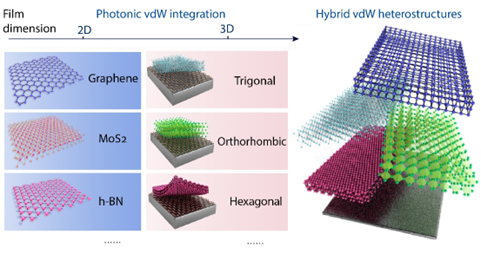Research on atomically thin two-dimensional (2D) materials has attracted tremendous interest over the past decade. One significant feature of them is that they can be exfoliated into freestanding forms for transferring and stacking at will with other prefabricated structures.
 Figure 1. 2D and 3D nanomembranes for photonic van der Waals integration. Image Credit: Washington University in St. Louis
Figure 1. 2D and 3D nanomembranes for photonic van der Waals integration. Image Credit: Washington University in St. Louis
Recent advances on 2D materials-assisted epitaxy and layer lift-off technologies have permit a wide range of single-crystalline three-dimensional (3D) thin-films that can also be delaminated from parent substrate into freestanding form with artificially defined van der Waals interfaces.
The scope of van der Waals (vdW) integration, a physical assembly strategy originally proposed in 2D materials society to construct vdW heterostructures, is thus expanded with the participation of freestanding 3D nanomembranes and hybrid 2D and 3D vdW heterostructures (Fig. 1). A recent framework on the vdW integration including 2D materials and exfoliated 3D nanomembranes for photonic applications is published recently on Nature Reviews Materials (DOI: 10.1038/s41578-023-00558-w) by an international team of researchers from Washington University in St. Louis, National University of Singapore, University of California Los Angeles, and Sungkyunkwan University.
As previous attention was main concentrated on 2D materials-based photonic vdW integration, we anticipate this comprehensive review can serve as a guideline for researchers work in this field, with detailed discussions from 2D and 3D nanomembranes preparation to device implementation. Conventional heteroepitaxy has fundamental constraints on lattice matching between epilayer and substrate, which greatly limit the available material combos for heterogeneous integration. In contrast, given that now functional 3D materials such as electro-optical, magneto-optical, piezoelectric, optical gain, and nonlinear media can be readily delaminated into freestanding form for integration of arbitrary prefabricated photonic templates, an ideal playground thus unfolds for advanced hetero-integrated photonics in previously inaccessible device structures. Emergent opportunities also await on flexible and bio-compatible photonic applications.